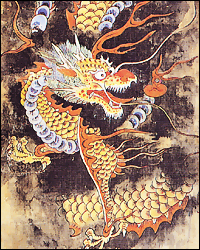|
|
|

Minwha
painting used for the decoration, on the basis of the belief
 inwha, are paintings in which the artists painted folk tales as well as portraying the lives of middle and lower class Koreans in ancient times. It is not known exactly when Minwha appeared in Korea, but Koreans have believed since ancient times that the paintings drive away disaster and, when used as a charm, they can achieve something that they hope for. Minwha is used mainly for decoration at home, but are also painted on folding screens used for keeping cold air away from different parts of a room. They were also painted on the covers of object used as means of transporting a bride, decorated with flowers, and painted on the fan on the date of a wedding.
inwha, are paintings in which the artists painted folk tales as well as portraying the lives of middle and lower class Koreans in ancient times. It is not known exactly when Minwha appeared in Korea, but Koreans have believed since ancient times that the paintings drive away disaster and, when used as a charm, they can achieve something that they hope for. Minwha is used mainly for decoration at home, but are also painted on folding screens used for keeping cold air away from different parts of a room. They were also painted on the covers of object used as means of transporting a bride, decorated with flowers, and painted on the fan on the date of a wedding.
In general, Minwha paintings by artists in Korea are based on shamanism, and the characters are often images of nature and animals. Pine trees symbolize a long life and the mountains in the paintings symbolize belief and respect toward nature. The painting of flowers represents prosperity, happiness, and benediction. Artists paint flowers such as peony blossoms, lotus blossoms, and chrysanthemums in many Minwha paintings. Birds such as a peacock, and mandarin duck are drawn as a pair in the Minwha and represent a happily married couple. Vegetables and fruits symbolize the prosperity and the wealth of descendants. Imaginary animals such as dragons, and Chinese phoenix represent one's prayers for prosperity and a long life.
Every Korean Minwha painting is not original as many are imitating samples of an earlier painting. Korean Minwha is appreciated for its practical use more than for it's original artistic value. Unknown artists who were not instructed painted a great number of pictures. Therefore, the paintings were discriminated against. They qualified as low quality paintings that only the lower class of people favored.
Even though many Minwha paintings were the result of an artist imitating another's technique of expression and subject matter, each painting has a characteristic of originality in its expression of the content. Though the artists repeat the same subject matter, one can see the individual character of each artist in describing the natural beauty of each simple painting. Each artist ended up gradually developing their own special characteristic technique over the course of repeating each painting.
Minwha became popular in modern times when feudalism was dissolved. Minwha is practical for fulfilling the cultural desires of the middle and lower class of people during the time when they started to show their sentiments and consciousness in society. There are a large variety of Minwha paintings, even though the form was not systematically developed as an art. Each artist painted a scene from Korean life that was important to them. One can often see Minwha in the Insa, district (get off at Anguk station on subway line number 3), which were used for decoration, and based on cultural beliefs.
(Sourced from WHAT'S ON SEOUL)
|
|
|
